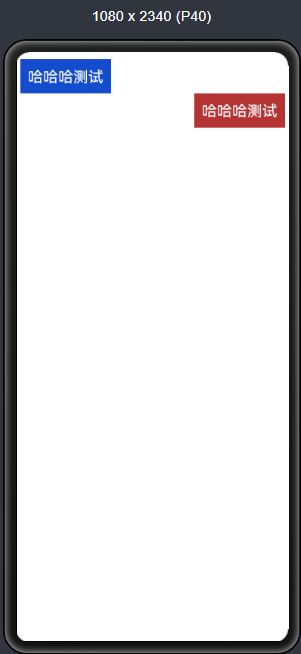

鸿蒙版微信聊天UI效果实现!
描述
最近开发中要做一个类似微信聊天的工单系统客服中心界面(安卓版)所以想着也模仿一个鸿蒙版(基于 Java UI 的,JS UI 版本的后期更新哈) 那么废话不多数说我们正式开始。
具体实现
mainabiilty 布局文件:
<DependentLayout
xmlns:ohos="http://schemas.huawei.com/res/ohos"
ohos:height="match_parent"
ohos:width="match_parent"
ohos:alignment="center"
ohos:orientation="vertical">
<DependentLayout
ohos:id="$+id:company_page_dl"
ohos:height="50vp"
ohos:width="match_parent"
ohos:orientation="horizontal"
ohos:align_parent_bottom="true"
>
<Button
ohos:id="$+id:main_my_btn"
ohos:width="match_content"
ohos:height="match_content"
ohos:text="发送"
ohos:text_size="35vp"
ohos:align_parent_right="true"
ohos:background_element="$graphic:background_btn"
>
Button>
<TextField
ohos:id="$+id:main_textfiled"
ohos:width="match_parent"
ohos:height="match_parent"
ohos:hint="请输入你的消息"
ohos:vertical_center="true"
ohos:text_size="50"
ohos:left_of="$id:main_my_btn"
ohos:layout_alignment="left"
>
TextField>
DependentLayout>
<ListContainer
ohos:above="$id:company_page_dl"
ohos:id="$+id:main_list"
ohos:height="match_parent"
ohos:width="match_parent"
>
ListContainer>
DependentLayout>
观察布局文件,我们可以看到写了一个列表控件 ListContainer 来装载发送出去的消息和接收到的消息。然后底部写了一个 TextField 控件来处理用户的输入和一个 button 来触发发送的动作。
逻辑代码
我们初始化对应控件并且 listContainer 和适配器绑定到一起:
private void initview() {
listContainer= (ListContainer) findComponentById(ResourceTable.Id_main_list);
textField= (TextField) findComponentById(ResourceTable.Id_main_textfiled);
mainbtn= (Button) findComponentById(ResourceTable.Id_main_my_btn);
mainbtn.setClickedListener(this);
myProvider=new MyProvider(data,getAbility());
listContainer.setItemProvider(myProvider);
myProvider.notifyDataChanged();//有新消息时,刷新ListView中的显示
}
①初始默认假数据
我们方便展示就写了 3 条假数据仅供展示:
private void initMsg() {
Msg msg1 = new Msg("你好",Msg.RECEIVED);
data.add(msg1);
Msg msg2 = new Msg("你好呀",Msg.SENT);
data.add(msg2);
Msg msg3 = new Msg("很高兴认识你",Msg.RECEIVED);
data.add(msg3);
}
②用户输入逻辑:
@Override
public void onClick(Component component) {
content=textField.getText().toString();
switch (component.getId()){
case ResourceTable.Id_main_my_btn:
if(!flag){
Msg msg = new Msg(content, Msg.SENT);
data.add(msg);
flag=true;
}else {
Msg msg = new Msg(content, Msg.RECEIVED);
data.add(msg);
flag=false;
}
myProvider.notifyDataChanged();//有新消息时,刷新ListView中的显示
textField.setText("");//清空输入框的内容
break;
default:
break;
}
}
我们通过一个布尔值 flag 来做一个开关处理用户输入的,动作轮流来处理是接收到消息还是发送出消息。发送消息:
Msg msg = new Msg(content, Msg.SENT);
data.add(msg);
接收消息:
Msg msg = new Msg(content, Msg.RECEIVED);
data.add(msg);
bena 类
package com.example.imdemo.bean;
public class Msg{
public static final int RECEIVED = 0;//收到一条消息
public static final int SENT = 1;//发出一条消息
private String content;//消息的内容
private int type;//消息的类型
public Msg(String content,int type){
this.content = content;
this.type = type;
}
public String getContent(){
return content;
}
public int getType(){
return type;
}
}
我们分别定义了 2 个常量和 2 个变量来处理我们的消息逻辑。
适配器
适配器 item.xml 布局:
<DirectionalLayout
xmlns:ohos="http://schemas.huawei.com/res/ohos"
ohos:height="match_content"
ohos:width="match_parent"
ohos:orientation="vertical">
<DirectionalLayout
ohos:id="$+id:left_layout"
ohos:height="match_content"
ohos:width="match_content"
ohos:layout_alignment="left"
ohos:background_element="$graphic:background_blue"
ohos:left_margin="5vp"
ohos:visibility="visible"
ohos:top_margin="10vp"
>
<Text
ohos:id="$+id:left_msg"
ohos:height="match_content"
ohos:width="match_content"
ohos:text="哈哈哈测试"
ohos:text_color="#fff"
ohos:text_size="20vp"
ohos:margin="10vp"
>
Text>
DirectionalLayout>
<DirectionalLayout
ohos:id="$+id:right_Layout"
ohos:height="match_content"
ohos:width="match_content"
ohos:layout_alignment="right"
ohos:background_element="$graphic:background_red"
ohos:right_margin="5vp"
ohos:visibility="visible"
>
<Text
ohos:id="$+id:right_msg"
ohos:height="match_content"
ohos:width="match_content"
ohos:text="哈哈哈测试"
ohos:text_color="#fff"
ohos:text_size="20vp"
ohos:margin="10vp"
>
Text>
DirectionalLayout>
DirectionalLayout>
item 布局预览效果:
 适配器逻辑代码:
适配器逻辑代码:
package com.example.imdemo.provider;
import com.example.imdemo.ResourceTable;
import com.example.imdemo.bean.Msg;
import ohos.aafwk.ability.Ability;
import ohos.agp.components.*;
import java.util.List;
public class MyProvider extends BaseItemProvider {
private List list;
private Ability ability;
public MyProvider(List list, Ability ability) {
this.list = list;
this.ability = ability;
}
@Override
public int getCount() {
return list.size();
}
@Override
public Object getItem(int i) {
return list.get(i);
}
@Override
public long getItemId(int i) {
return i;
}
@Override
public Component getComponent(int i, Component component, ComponentContainer componentContainer) {
ViewHodler hodler=null;
Msg msg = list.get(i);
if (component== null) {
component = LayoutScatter.getInstance(ability).parse(ResourceTable.Layout_item,null,false);
hodler=new ViewHodler();
hodler.leftLayout = (DirectionalLayout) component.findComponentById(ResourceTable.Id_left_layout);
hodler.rightLayout = (DirectionalLayout) component.findComponentById(ResourceTable.Id_right_Layout);
hodler.leftMsg = (Text) component.findComponentById(ResourceTable.Id_left_msg);
hodler.rightMsg = (Text) component.findComponentById(ResourceTable.Id_right_msg);
component.setTag(hodler);
} else {
hodler= (ViewHodler) component.getTag();
}
System.out.println("type--- > "+msg.getType());
if(msg.getType()==Msg.RECEIVED){
System.out.println("左边消息");
//如果是收到的消息,则显示左边消息布局,将右边消息布局隐藏
hodler.leftLayout.setVisibility(0);
hodler.rightLayout.setVisibility(1);
hodler.leftMsg.setText(msg.getContent());
}else if(msg.getType()==Msg.SENT){
System.out.println("右边消息");
//如果是发出去的消息,显示右边布局的消息布局,将左边的消息布局隐藏
hodler.rightLayout.setVisibility(0);
hodler.leftLayout.setVisibility(1);
hodler.rightMsg.setText(msg.getContent());
}
return component;
}
class ViewHodler{
DirectionalLayout leftLayout;
DirectionalLayout rightLayout;
Text leftMsg;
Text rightMsg;
}
}
我们通过在 getComponent 方法中通过小标 i 来遍历集合然后拿到里面每一个对应里面的 type 属性来判断是显示左边布局还是右边布局。
也就是对应的发送消息和接收消息的 UI,我们通过简单布局显示影藏来实现消息的左右两边显示效果,到此整个仿微信聊天的布局 UI 效果就讲完了 。
总结
鸿蒙的仿微信聊天 UI 效果实现起来相对比较简单,其实还有一种办法那就是 ListContainer 的多布局也是通过 bean 里面的标识来显示左右不同的布局实现聊天界面的效果。因为篇幅有限这里就不展开讲了有兴趣的同学可以私下研究。最后希望我的文章能帮助到各位解决问题,以后我还会贡献更多有用的代码分享给大家。
项目地址:
https://gitee.com/qiuyu123/hms_im_demo
编辑:jq
声明:本文内容及配图由入驻作者撰写或者入驻合作网站授权转载。文章观点仅代表作者本人,不代表电子发烧友网立场。文章及其配图仅供工程师学习之用,如有内容侵权或者其他违规问题,请联系本站处理。
举报投诉
-
鸿蒙版微信消息弹窗不能进入聊天界面2025-12-11 260
-
html5仿微信聊天开发|仿微信1v1聊天|仿微信表情2018-07-01 2906
-
请问labview怎么实现聊天的气泡效果?2019-05-15 3934
-
iOS如何抽奖轮盘效果实现思路2020-04-28 1985
-
鸿蒙应用开发的JS UI框架如何实现高德地图的访问?2022-04-28 4107
-
微信聊天记录删除了怎么恢复-最简单的方法2017-06-16 4493
-
微信误删聊天记录怎么恢复? 误删了微信聊天记录如何找回2017-07-29 4850
-
怎么恢复微信聊天记录2018-06-05 9371
-
苹果误删微信聊天记录怎么恢复2018-07-11 1879
-
微信如何找回聊天记录2018-07-16 2759
-
怎样找回被删的微信聊天记录2018-07-26 1501
-
微信聊天记录删除了怎么恢复?怎么查找2018-07-31 1444
-
微信聊天记录删除了怎么办?恢复微信聊天记录2018-08-03 3728
-
这么偷偷查询老婆的微信聊天信息2018-08-19 8920
-
如何彻底删除微信聊天记录2019-08-26 8159
全部0条评论

快来发表一下你的评论吧 !

